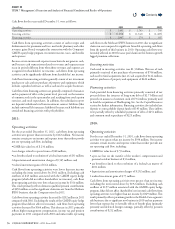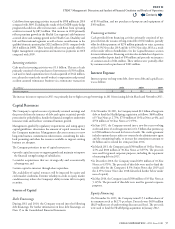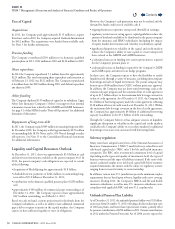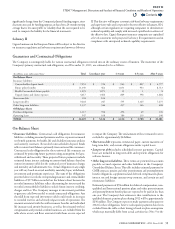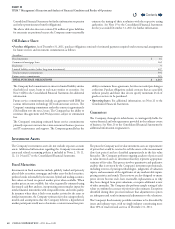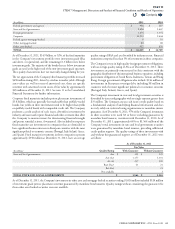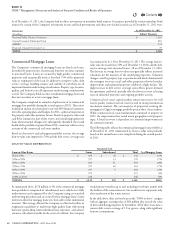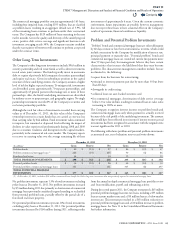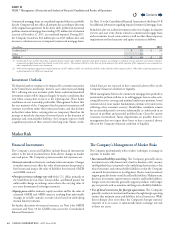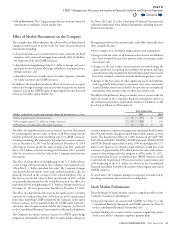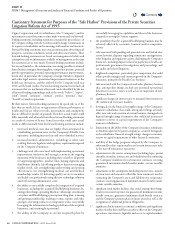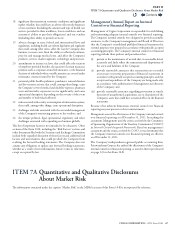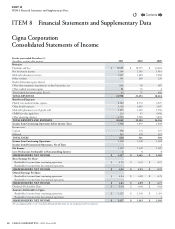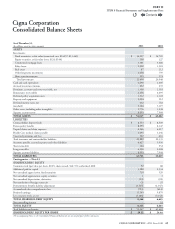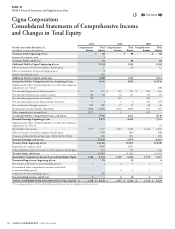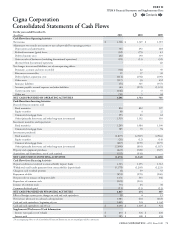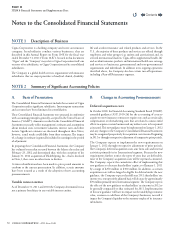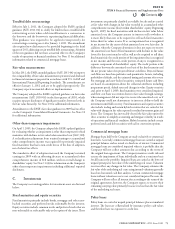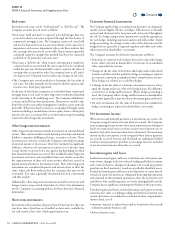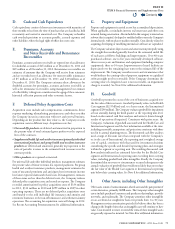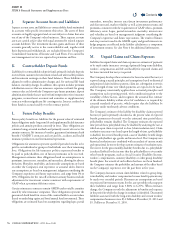Cigna 2011 Annual Report Download - page 88
Download and view the complete annual report
Please find page 88 of the 2011 Cigna annual report below. You can navigate through the pages in the report by either clicking on the pages listed below, or by using the keyword search tool below to find specific information within the annual report.
66 CIGNA CORPORATION2011 Form10K
PART II
ITEM 7 Management’s Discussion and Analysis of Financial Condition and Results of Operations
Cautionary Statement for Purposes of the “Safe Harbor” Provisions of the Private Securities
Litigation Reform Act of 1995
Cigna Corporation and its subsidiaries (the “Company”) and its
representatives may from time to time make written and oral forward-
looking statements, including statements contained in press releases, in
the Company’s lings with the Securities and Exchange Commission, in
its reports to shareholders and in meetings with analysts and investors.
Forward-looking statements may contain information about nancial
prospects, economic conditions, trends and other uncertainties. ese
forward-looking statements are based on management’s beliefs and
assumptions and on information available to management at the time
the statements are or were made. Forward-looking statements include,
but are not limited to, the information concerning possible or assumed
future business strategies, nancing plans, competitive position, potential
growth opportunities, potential operating performance improvements,
trends and, in particular, the Company’s strategic initiatives, litigation
and other legal matters, operational improvement initiatives in the
health care operations, and the outlook for the Company’s full year
2012 and beyond results. Forward-looking statements include all
statements that are not historical facts and can be identied by the use
of forward-looking terminology such as the words “believe”, “expect”,
“plan”, “intend”, “anticipate”, “estimate”, “predict”, “potential”, “may”,
“should” or similar expressions.
By their nature, forward-looking statements: (i) speak only as of the
date they are made, (ii) are not guarantees of future performance or
results and (iii) are subject to risks, uncertainties and assumptions
that are dicult to predict or quantify. erefore, actual results could
dier materially and adversely from those forward-looking statements
as a result of a variety of factors. Some factors that could cause actual
results to dier materially from the forward-looking statements include:
1. increased medical costs that are higher than anticipated in
establishing premium rates in the Company’s Health Care
operations, including increased use and costs of medical services;
2. increased medical, administrative, technology or other costs
resulting from new legislative and regulatory requirements imposed
on the Company’s businesses;
3. challenges and risks associated with implementing operational
improvement initiatives and strategic actions in the ongoing
operations of the businesses, including those related to: (i) growth
in targeted geographies, product lines, buying segments and
distribution channels, (ii) oering products that meet emerging
market needs, (iii) strengthening underwriting and pricing
eectiveness, (iv) strengthening medical cost and medical
membership results, (v) delivering quality service to members
and health care professionals using eective technology solutions
and (vi) lowering administrative costs;
4. the ability to successfully complete the integration of acquired
businesses, including the acquired HealthSpring businesses by,
among other things, operating Medicare Advantage coordinated
care plans and HealthSpring’s prescription drug plan, retaining
and growing membership, realizing revenue, expense and other
synergies, renewing contracts on competitive terms, successfully
leveraging the information technology platform of the acquired
businesses, and retaining key personnel;
5. the ability of the Company to execute its growth plans by
successfully leveraging its capabilities and those of the businesses
acquired in serving the Seniors segment;
6. the possibility that the acquired HealthSpring business may be
adversely aected by economic, business and/or competitive
factors;
7. risks associated with pending and potential state and federal class
action lawsuits, disputes regarding reinsurance arrangements,
other litigation and regulatory actions challenging the Company’s
businesses, including disputes related to payments to health care
professionals, government investigations and proceedings, and
tax audits and related litigation;
8. heightened competition, particularly price competition, that could
reduce product margins and constrain growth in the Company’s
businesses, primarily the Health Care business;
9. risks associated with the Company’s mail order pharmacy business
that, among other things, include any potential operational
deciencies or service issues as well as loss or suspension of state
pharmacy licenses;
10. signicant changes in interest rates or sustained deterioration in
the commercial real estate markets;
11. downgrades in the nancial strength ratings of the Company’s
insurance subsidiaries, that could, among other things, adversely
aect new sales and retention of current business; downgrades in
nancial strength ratings of reinsurers, that could result in increased
statutory reserves or capital requirements of the Company’s
insurance subsidiaries;
12. limitations on the ability of the Company’s insurance subsidiaries
to dividend capital to the parent company as a result of downgrades
in the subsidiaries’ nancial strength ratings, changes in statutory
reserve or capital requirements or other nancial constraints;
13. inability of the hedge programs adopted by the Company to
substantially reduce equity market and certain interest rate risks
in the run-o reinsurance operations;
14. adjustments to the reserve assumptions (including lapse, partial
surrender, mortality, interest rates and volatility) used in estimating
the Company’s liabilities for reinsurance contracts covering
guaranteed minimum death benets under certain variable
annuities;
15. adjustments to the assumptions (including interest rates, annuity
election rates and amounts collectible from reinsurers) used in
estimating the Company’s assets and liabilities for reinsurance
contracts covering guaranteed minimum income benets under
certain variable annuities;
16. signicant stock market declines, that could, among other things,
result in increased expenses for guaranteed minimum income
benet contracts, guaranteed minimum death benet contracts
and the Company’s pension plans in future periods as well as the
recognition of additional pension obligations;
17. signicant deterioration in economic conditions and signicant
market volatility, that could have an adverse eect on the Company’s
operations,investments, liquidity and access to capital markets;
Contents
Q


